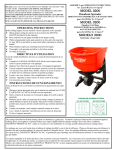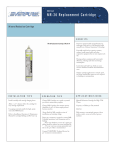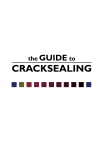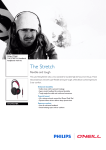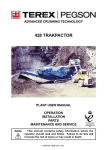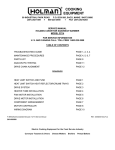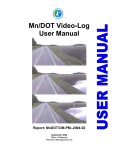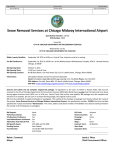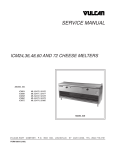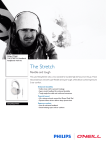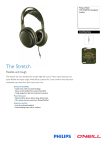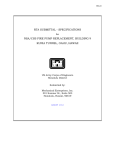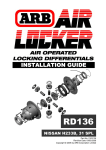Download INSTALLATION INSTRUCTIONS HOT APPLIED
Transcript
420 N. Roosevelt Ave. • Chandler AZ 85226 1-800-227-4059 • (602) 276-0406 • FAX (480) 961-0513 www.deeryamerican.com INSTALLATION INSTRUCTIONS HOT APPLIED SEALANTS APRIL 2011 READ BEFORE USING THIS PRODUCT OVERVIEW: DEERY Hot-Applied Sealants are single component, virgin polymer and /or recycled rubber modified asphalts or resins supplied in solid block form. These products are used to seal or fill cracks or joints in asphalt concrete or portland cement concrete highway, street, aviation and parking lot pavements. To use, product is removed from the package, heated in a melter and applied to the pavement. These products are manufactured for different specifications, climates and uses as listed on DEERY Product Data Sheets. Suitability of the sealant used should be determined by the user prior to application. MELTING and HEATING: DEERY Hot-Applied Sealants are heated in a hot-oil jacketed melter with constant mechanical agitation and a calibrated thermometer to monitor temperature. Melters should meet requirements of Appendix X1.1 of ASTM D6690. Heat transfer oil should not exceed 525°F (274°C). The melter must be able to safely heat product to 400°F (204°C). Note: SuperStretch, Stretch Pro PL, and Asphalt Type 3 Sealants may also be melted in approved direct fired melters. Start melting by carefully adding small quantities (up to 25% of capacity) to the melter with the agitator off to avoid splashing. Heat and agitate sealant until it begins to melt to a liquid. Then additional sealant is added, with the agitator off. Continue heating and agitating until sealant reaches the Recommended Application Temperature of 380-400 F (193-204C). Additional sealant may be added during installation as quantity in the melter decreases. DEERY Hot-Applied Sealants are pre-reacted and can be applied immediately after heating to the Recommended Application Temperature. Best results are obtained when sealant is applied as soon as application temperature is reached. Sealant application life at application temperature exceeds 6 hours and may be extended by adding fresh product as quantity in the melter decreases during use. During application, sealant temperature is to be maintained in the Recommended Application Temperature range. If during use, especially when adding sealant to the melter, sealant temperature drops below the Recommended Application Temperature, installation should stop and not resume until sealant has been heated back to the Application Temperature range. Sealant shall be agitated during installation to assure uniformity. Do not heat sealant above the Maximum Heating Temperature of 400F (204 C). Prolonged heating at or above the Recommended Application Temperature may cause sealant to deteriorate and lose properties. If this happens, sealant should be immediately removed from the melter and discarded. If all heated sealant will not be used that day, reduce quantity in the melter to approximately 25% or less of melter capacity prior to shut down. Product may be reheated once to application temperature after initial heat up. When reheating, add additional blocks of sealant equal to the amount being reheated in the melter and proceed with heating and installation. PAVEMENT TEMPERATURES: DEERY Hot-Applied Sealants should only be applied when pavement temperature exceeds 40°F (4°C). Sealant installation at lower pavement temperatures may reduce adhesion. If pavement temperature is lower than 40°F (4°C), it may be warmed using a hot air lance. If installing at lower pavement temperature than 40°F (4°C), insure that cracks or joints are dry and product temperature should be maintained at the maximum heating temperature. Do not heat product higher than the maximum heating temperature to try to make up for cold or damp conditions. If installing product at night, assure that dew is not forming on the pavement surface. Applied product should be checked by qualified personnel to assure that adhesion is adequate. TRAFFIC CONTROLS: Place traffic controls in accordance with Part 6, Temporary Controls, of the FHWA Manual on Uniform Traffic Control Devices (MUTCD) to protect the work site for the duration of the repairs. CRACK and JOINT PREPARATION: Proper surface preparation is critical for adequate sealant adhesion. Sealants work best if applied to clean dry surfaces. Cracks and joints must be free of moisture, dirt, dust, loose aggregate, or other contaminants to prevent premature adhesion loss. For best results, clean surfaces immediately before sealant application. Various options are used for crack or joint preparation. One or more of the following methods may be utilized: 1. Oil Free Compressed air at a minimum 90 psi (620kpa) 2. Hot Air Lance (Note-Hot Air Lances work best on dry or slightly damp pavement) 3. Routers (make sure all dust has been thoroughly removed from crack after routing) 4. Sawing Equipment (assure all residue is removed) 5. Power Wire Brushing (for cracks in asphalt concrete only, do not use in Portland cement concrete joints or cracks) 6. Sand or Abrasive Blasting After crack or joint widening and debris removal, and just prior to product installation, final cleaning shall use high pressure 90 psi (620kpa) minimum, dry, oil free compressed air to remove any remaining dust. Both sides of the crack or joint shall be cleaned. Surfaces should be inspected to assure that adequate cleanliness and dryness have been achieved. CRACK and JOINT CONFIGURATION: In most applications, ideal crack and joint configuration is 1:1 depth to width ratio. Cracks or joints can be routed to provide reservoirs with a 1:1 ratio. Commonly used reservoir dimensions are ½ x ½ inch (12 x 12 mm) or ¾ x ¾ inch (19 x 19 mm). In some applications, mainly in very cold climates, shallower configurations with a 1 to 4 depth to width ratio, typically 1-1/2 inch wide by 3/8 inch deep (40 x 10 mm) are used for high amounts of thermal crack opening. Rout or saw cut the pavement to create a reservoir sufficient in size to accommodate thermal movement. Maximum crack or joint width should not exceed 1 ½ inches (40mm). To control depth and sealant usage, a compatible heat resistant backer rod meeting ASTM D5249 Type I can be used. For random, longitudinal and other non-working type cracks, surface overbands are commonly used. Overbands should not exceed 4 inches (10cm) wide and should not be over 1/16inch (1.6 mm) thick. SEALANT APPLICATION METHOD: DEERY sealants can be applied by hose, hand held pour pots, or wheeled pour pots (banders). Sealant is applied to the cleaned crack or joint, with slight overfilling and then leveled using a narrow squeegee to fill the crack or joint and minimize sealant on the surface. Maximum sealant thickness on the surface should not exceed 1/16 inch (1.6mm) and bands should not exceed 4 inches (10 cm) wide. Some specifications require recessed installations. For these, apply sealant to the crack or joint from the bottom up leaving the cured sealant 1/8 to ¼ inch (3 -6 mm) below the pavement surface. Concrete joints should be filled to 1/8-1/4 inch (3-6mm) below the pavement surface. This method reduces pick up and tracking by traffic. If desired, DEERY No Stick (Part No 80100) can be used to reduce surface tack. ©2011, Crafco, Inc., All Rights Reserved INSTALLATION PRECAUTIONS: In some cases, additional consideration needs to be given to product selection and installation. Parking Lots and Other Areas Subjected to Slow Moving Traffic and Pedestrians: Product used must be stiff enough at hot summer temperatures to resist pick up and should not be applied on top of the pavement surface. DEERY No Stick (Part No 80100) can be used to reduce surface tack. Pavement to Receive Hot Mix Asphalt Concrete Overlay: Sealant will be subjected to high heat from the overlay and stresses during compaction that may produce bumps in the overlay surface. If the pavement is to be overlayed the same year, sealant should be installed recessed 1/4 inch (6mm) below the pavement surface with no sealant on the surface. For additional information contact your DEERY representative. Pavement to Receive a Surface Treatment or Seal Coat: Solvents or carriers in some surface treatments may soften sealant. Prior to placing a surface treatment or seal coat, a test strip should be placed to verify compatibility of sealant and the surface treatment to assure there are no detrimental effects. High Severity Cracked Areas: Highly cracked areas (fatigue cracks in wheel paths) should not be treated by covering cracks with sealant because pavement friction may be affected. These cracks can be filled if followed by a surface treatment or overlay to restore friction. Fuel or Oil Spill Areas: DEERY Hot-Applied Sealants are not fuel resistant and should not be used in fuel or oil spill areas due to possible softening which may occur. Sealant will not adhere to pavement surfaces that are contaminated with fuel or oil spills. Crack Sealing in Pavements with Surface Treatments: When crack sealing pavements with chip seals, slurry seals, or open graded friction courses, routing should extend through the surface treatment layer into the underlying asphalt concrete. This anchors sealant into solid pavement for better bonding. Pavements Treated With Anti-Icing Agents: Presence of anti-icing agents on pavements may reduce sealant adhesion. For pavements recently treated with anti-icing agent, apply a small amount of sealant to test adhesion. Allow sealant to cool to the pavement surface temperature and then attempt to dislodge it by prying the edges. If sealant is easily dislodged, the anti-icing agent is not permitting full adhesion. If sealant remains bonded after attempting to dislodge, sealing may proceed. If sealant is easily dislodged, additional cleaning is required prior to continuing. Air blowing, wire brushing, routing or use of a heat lance to clean crack surfaces can be helpful for improving adhesion. After additional cleaning, adhesion should be rechecked. If sealant is still not adhering, the project should be delayed until natural environmental processes rid the pavement surface of the anti-icing agent. It is generally recommended to seal pavements that receive heavy anti-icing treatments in the fall before deicing treatment application begins. Sealing in Hot Weather: Hot weather does not adversely affect sealant quality or properties but does increase set up times, and potential for pick up or tracking. In hot weather, stiffer low penetration sealants are more resistant to tracking than softer high penetration sealants. Users should determine suitability of the sealant used for conditions during installation. Recommendations for sealing in hot weather follow: 1. Use recessed reservoir installation configurations and leave sealant flush to ¼ inch (6mm) below the pavement surface. 2. When using surface overbands, stop work when pavement temperature exceeds 122F (50C). (Does not apply to recessed reservoirs) 3. Avoid overband installations on longitudinal cracks and joints in wheelpaths. Tires operate at high temperatures and continuous contact with sealant can increase tracking and pick up. 4. When using surface overbands, use a narrow squeegee to minimize amount of sealant left on the surface. 5. Use sealant products designed for hot climate installations. 6. Allow more cooling time and maintain traffic control until sealant has cooled. DEERY No Stick (Part No. 80100) is very effective in hot weather to reduce time to opening to traffic. MELTER CLEAN OUT: If melters used require clean out, follow manufacturer’s instructions. If solvent is used, insure it does not contaminate product because dilution and flash problems may occur. PRODUCT STORAGE: Pallets of DEERY Hot-Applied Sealant are protected with a weather resistant covering. During storage, this covering must be intact to prevent boxes from getting wet. If wet, boxes may lose strength and crush. Rips in the pallet covering should be repaired to maintain packaging integrity. Pallets should be stored on a dry, level surface with good drainage. Pallets should not be stacked because crushing of bottom boxes may occur. Product properties are not affected by packaging deterioration. SAFETY PRECAUTIONS: Since these products are heated to elevated temperatures, it is essential that operations be conducted safely. All personnel need to be aware of hazards of using hot- applied materials and safety precautions. Before use, the crew should read and understand product use and safety information on the box and the product MSDS which is included with each pallet. All workers should use required Personal Protective Equipment (PPE) when working on the sealing project. User should check D.O.T. requirements for transportation of product at elevated temperatures above 212°F (100°C). HAZARDS WITH HOT-APPLIED MATERIALS: Skin contact with hot materials causes burns. Over exposure to fumes may cause respiratory tract irritation, nausea, or headaches. Precautions are to be taken to prevent contact with hot material and to avoid inhalation of fumes for everyone in the vicinity. Safety precautions should include: 1. Protective clothing and PPE to prevent skin contact with hot material. 2. Care when adding product to melters to reduce splashing. 3. Careful operation of wands or pour pots that apply product. 4. Traffic and pedestrian controls which meet or exceed MUTCD requirements to prevent access to work areas while product is in a molten state. 5. Avoidance of material fumes. 6. Proper application configurations with a minimum amount of material excess. 7. Appropriate clean up of excessive applications or product spills. ADDITIONAL INFORMATION: Additional information on use and application of these products is available on the DEERY Products Website at www.deeryamerican.com or by contacting your DEERY sales representative. This information includes: 1. Product Data Sheets 2. Material Safety Data Sheet (MSDS) 3. DEERY Pavement Preservation Products Guide ©2011, Crafco, Inc., All Rights Reserved


